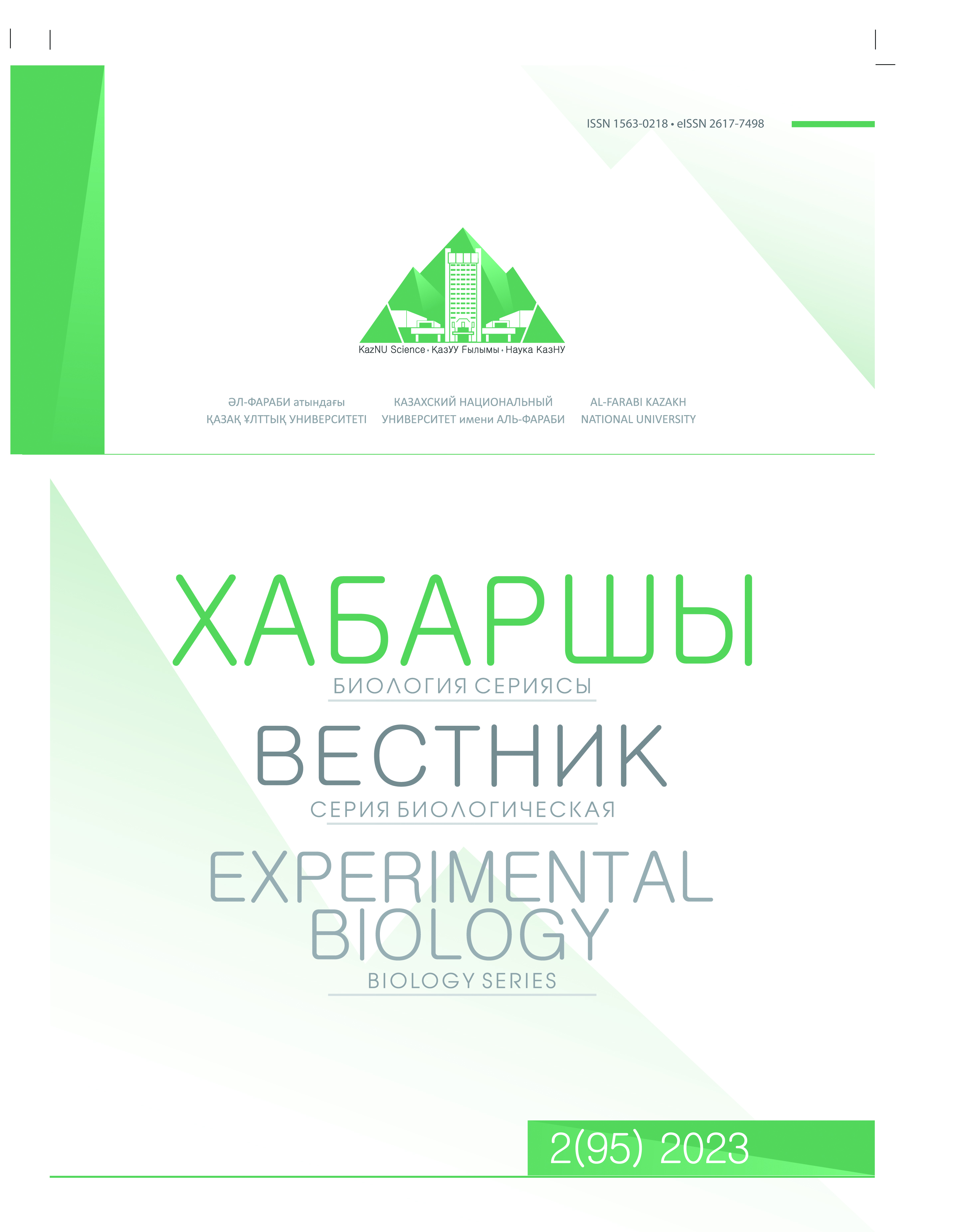MORPHOLOGICAL FEATURES OF THE ACTION OF RONCOLEUKIN ON THE INTERNAL ORGANS OF WHITE MICE
DOI:
https://doi.org/10.26577/eb.2023.v95.i2.014Keywords:
IL-2, planimetric image analysis, chronic inflammation model, RonkoleukinAbstract
Chronic inflammatory diseases are one of the leading causes of death in the world. A number of pathological conditions are associated with chronic inflammation, such as chronic obstructive pulmonary disease, rheumatoid arthritis, metabolic syndrome, type 2 diabetes mellitus, cardiovascular, chronic kidney disease, cancer, neurodegenerative and autoimmune diseases. To address a number of issues related to this problem, reliable models of chronic inflammation are needed. A number of chemical inductors of this state are known from the literature. One of them is interleukin-2. Roncoleukin is a dosage form of recombinant human interleukin-2. To date, few studies have been presented on changes at the tissue level under the influence of IL-2. In this work, we studied the patterns of morphological changes in the lungs, liver, kidneys, spleen, and thymus of CD-1 mice under the influence of low and high doses of Roncoleukin. We have shown that the drug contributes to an increase in the mass of the spleen by 2 times and a decrease in the mass of the thymus by 1.5 times. Roncoleukin has a stimulating effect on the immunocompetent compartment, leading to cell proliferation of T-dependent zones of the spleen and thymus cortex. In the visceral organs, under its action, a picture of a chronic inflammatory process develops.
References
Abbas A.K. et al. Revisiting IL-2: Biology and therapeutic prospects: 25 // Sci. Immunol. 2018. Vol. 3, № 25. P. eaat1482.
Bachmann M.F., Oxenius A. Interleukin 2: from immunostimulation to immunoregulation and back again: 12 // EMBO Rep. 2007. Vol. 8, № 12. P. 1142–1148.
Bancroft J.D., Suvarna S.K., Layton C. Theory and practice of histological techniques. 8th ed. Elsevier, 2019. 573 p.
Barnes P.J. Cellular and molecular mechanisms of asthma and COPD // Clin. Sci. Lond. Engl. 1979. 2017. Vol. 131, № 13. P. 1541–1558.
Calder P.C. et al. Health relevance of the modification of low grade inflammation in ageing (inflammageing) and the role of nutrition // Ageing Res. Rev. 2017. Vol. 40. P. 95–119.
Chavez A.R. de V. et al. Pharmacologic administration of interleukin-2 // Ann. N. Y. Acad. Sci. 2009. Vol. 1182. P. 14–27.
Dutcher J.P. et al. High dose interleukin-2 (Aldesleukin) – expert consensus on best management practices-2014 // J. Im- munother. Cancer. 2014. Vol. 2, № 1. P. 26.
Franceschi C. et al. Inflammaging and “Garb-aging” // Trends Endocrinol. Metab. TEM. 2017. Vol. 28, № 3. P. 199–212.
Frazier K.S. et al. Proliferative and nonproliferative lesions of the rat and mouse urinary system // Toxicol. Pathol. 2012. Vol. 40, № 4 Suppl. P. 14S-86S.
Frostegård J. Immunity, atherosclerosis and cardiovascular disease // BMC Med. 2013. Vol. 11. P. 117.
Furman D. et al. Chronic inflammation in the etiology of disease across the life span // Nat. Med. 2019. Vol. 25, № 12. P. 1822–1832.
Liang X. et al. Inhibiting systemic autophagy during interleukin 2 immunotherapy promotes long-term tumor regression: 11 // Cancer Res. 2012. Vol. 72, № 11. P. 2791–2801.
Malek T.R. The biology of interleukin-2 // Annu. Rev. Immunol. 2008. Vol. 26. P. 453–479.
Malek T.R., Castro I. Interleukin-2 receptor signaling: at the interface between tolerance and immunity: 2 // Immunity. 2010. Vol. 33, № 2. P. 153–165.
Mitra S., Leonard W.J. Biology of IL-2 and its therapeutic modulation: Mechanisms and strategies // J. Leukoc. Biol. 2018. Vol. 103, № 4. P. 643–655.
Patil K.R. et al. Animal Models of Inflammation for Screening of Anti-inflammatory Drugs: Implications for the Discovery and Development of Phytopharmaceuticals // Int. J. Mol. Sci. 2019. Vol. 20, № 18. P. 4367.
Prasad S., Sung B., Aggarwal B.B. Age-Associated Chronic Diseases Require Age-Old Medicine: Role of Chronic Inflam- mation // Prev. Med. 2012. Vol. 54, № Suppl. P. S29–S37.
Renne R. et al. Proliferative and nonproliferative lesions of the rat and mouse respiratory tract // Toxicol. Pathol. 2009. Vol. 37, № 7 Suppl. P. 5S-73S.
Saltiel A.R., Olefsky J.M. Inflammatory mechanisms linking obesity and metabolic disease // J. Clin. Invest. 2017. Vol. 127, № 1. P. 1–4.
Schwartz R.N., Stover L., Dutcher J.P. Managing toxicities of high-dose interleukin-2 // Oncol. Williston Park N. 2002. Vol. 16, № 11 Suppl 13. P. 11–20.
Spolski R., Li P., Leonard W.J. Biology and regulation of IL-2: from molecular mechanisms to human therapy: 10 // Nat. Rev. Immunol. 2018. Vol. 18, № 10. P. 648–659.
Thoolen B. et al. Proliferative and Nonproliferative Lesions of the Rat and Mouse Hepatobiliary System // Toxicol. Pathol. 2010. Vol. 38, № 7_suppl. P. 5S-81S.
Volkov V.P. Fynkcionalnaya immunomorfologia timusa v aspekte ontogeneza [Functional immunomorphology of the thymus in the aspect of ontogenesis]: 8 (45) // Innovacii v nauke. Novosibirsk, Russia: ANS «SibAK», 2015. № 8 (45). P. 91–99.
Volkov V.P. Novyy algoritm morfometricheskoi ocenki fynkcionalnoi immunomorfologii selezenki [New Algorithm for Morphometric Evaluation of Functional Immunomorphology of the Spleen]: 5-6 (18) // Univers. Medicina i Farmakologiya. Russia, Moskow: OOO «Mezhdunarodnyj centr nauki i obrazovaniya», 2015. № 5-6 (18).
Zuo L. et al. Inflammaging and Oxidative Stress in Human Diseases: From Molecular Mechanisms to Novel Treatments // Int. J. Mol. Sci. 2019. Vol. 20, № 18. P. E4472.












